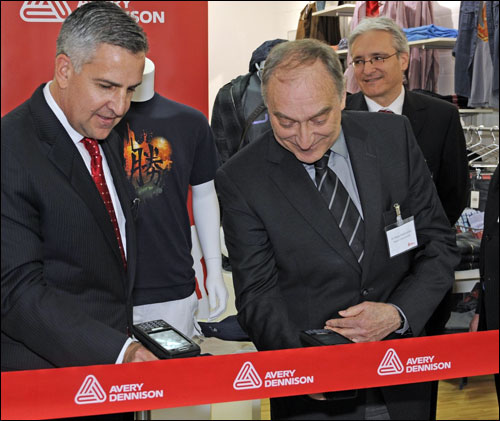Today, Avery Dennison, a Fortune 500 provider of RFID solutions and other products, opened its first Customer Design and Innovation Center in Europe. Top managers from the company descended on the facility, nestled in the hills in the German town of Sprockhoevel (near Duesseldorf), to demonstrate to the press and other visitors how the entire garment and footwear supply chain can be made more efficient with the use of passive EPC Gen 2 RFID tags attached to apparel.
The 2,800-square-meter (30,140-square-foot) center will focus on European customers and highlight a wide variety of Avery Dennison’s products and services. In the facility’s design lab, for instance, customers can learn about the latest trends in apparel fabrics, colors and styles, as well as the accompanying label possibilities for those items. After hearing about the trends, visitors can then view RFID-based hangtags and care tags made for those goods, and visualize how the tagged items can move throughout the supply chain.

Shawn Neville, the group VP of Avery Dennison’s Retail Branding and Information Solutions division (the company’s newly renamed Retail Information Services unit), views the new center in the heart of Germany’s industrial belt as a key part of the expansion of RFID’s use for apparel tagging—a market, he believes, that is essentially untapped.
“We see this as a global center,” Neville says. “Our very simple goal here is [to advance] the adoption of RFID in the global retail apparel market. Only a fraction of the market has adopted RFID. There are 100 billion units around the world being produced in apparel, and less than 1 billion—less than 1 percent—are RFID-enabled. The impression is that RFID is very complex and challenging to execute. Our challenge is to make it simpler, clearer and executable for retailers and brands around the world.”
According to Neville, Avery Dennison’s strategy for RFID is to convince apparel manufacturers and retailers that the greatest benefits can be derived by tagging items at the source—which, he says, is the simplest way to implement RFID. At the innovation center, which he says was inspired by the RFID Innovation Center that Metro Group opened in 2004 in the nearby city of Neuss (see Metro Launches RFID Test Center), customers can see the possibilities of RFID tagging from source to sale, along with Avery Dennison’s service offerings for each step of the way.
At the start of the day’s proceedings, Neville performed a ceremonial RFID ribbon reading, using a handheld RFID interrogator to read an Avery Dennison passive EPC Gen 2 tag embedded in the ribbon (instead of using a scissor to cut the ribbon). Richard Bauer, Avery Dennison’s director of RFID program development, then gave members of the press a tour of his company’s new facility, including several stations devoted to radio frequency identification. Bauer emphasized how RFID-tagged items and related information systems can help companies reduce costs by speeding garments through the supply chain, thereby providing an accurate and transparent overview of those goods and also reducing theft. At one station, visitors saw how RFID hangtags and care tags are manufactured; at another, they were offered a T-shirt from Avery Dennison’s own UNITI demonstration apparel brand, used for showing customers the firm’s products and solutions. The T-shirts were customized for the journalists just as they might be for visiting Avery Dennison customers—for instance, by applying a magazine’s logo onto the shirt. Guests were also presented with their own garment hangtags displaying their pictures on the tags.
In an adjoining room, which represented a typical distribution center, RFID-tagged items were moved along a conveyer belt, and the tags were interrogated to account for those goods, and to represent the shipping and receiving processes. The third room represented a retail store’s stock room, and was used to highlight the inventory-management services that Avery Dennison could offer retailers. Finally, the tagged items were moved onto the sales floor, where inventory, point-of-sale and anti-theft applications were demonstrated.
The Sprockhoevel site is Avery Dennison’s second innovation center; the company opened the first such center in Ohio, in November 2010. According to Bauer, approximately 15 or 20 organizations have already taken the opportunity to visit the Ohio center and have the “mystery taken out” of RFID. At the Sprockhoevel facility’s official opening, the company also unveiled what it dubs its “breakthrough high-definition graphics transfer process,” designed to serve the $6 billion market for exterior garment graphic embellishments.
In addition, the center showcases the company’s new solutions for sustainable packaging—a nearly $5 billion market in the apparel, footwear and accessories segment, including Greenprint, which the firm describes as “a blueprint for retail apparel customers to better understand the environmental consequences of their branding and packaging materials decision-making.” The diagnostic tool, Avery Dennison reports, translates complex data into a user-friendly snapshot of six impact categories, such as greenhouse gases, energy usage and solid waste, and quantifies the benefits of switching to more sustainable materials.
Avery Dennison is currently in the process of rolling out its RFID products and solutions through its existing network of service bureaus, Bauer says, and is providing them to its customers. To date, he says, some 50 or 60 customers—most in Asia—are already making their own RFID labels at their garment plants, and then applying them to clothing items while still at the factories.

